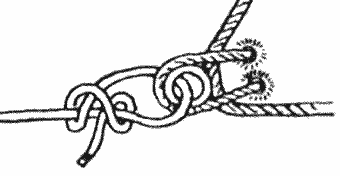Maintenance
Centreboard case painting
Sea Anchor
Thole Pins
Buntline Hitch
Maintenance
The need for maintenance on a wooden boat is primarily
for the protection of the wood. When a clinker built boat is
new, it is usual for it to be varnished. At this point it should
be pointed out that polyurethane varnish is no good at all on
a clinker boat. Polyurethane is all right when used on plywood
craft, but it is vital to encapsulate the wood completely, or
the varnish will peel off in large pieces. It is obviously not
possible to encapsulate a plank on a clinker boat due to the
overlapping of the boards in the hull, so common yacht varnish
should be used.
I found that with a boat kept on a mooring, the
horizontal surfaces soon weathered, so I determined that all
such surfaces should be painted. One coat of paint is 4 or 5
times thicker than a coat of varnish, so it is a sad fact that
paint is better for the job. The surfaces mentioned comprise
the benches, gunwhales, and bow and stern sheets.
The paint used need not be expensive marine paint.
Any good modern non-polyurethane paint may be used, and I have
had good service from Tekaloid Coach Enamel. I use two coats
of undercoat, rubbed down after each coat, followed by one coat
of gloss. The undercoat is very easy to apply; going on like
milk, and when dry, is easy to rub down.
Centreboard case painting
This is a very politically incorrect method, which
works very well. When afloat, whilst moored, just before low
water, you fill up the centreboard case from the top, with any
sort of oil-based paint. Then as the tide goes out, the water
level falls and the boat takes the ground. The paint runs away
and the inside of the case is painted. There are those that
say that you cannot paint wet surfaces, but we have all painted
the bottom of a jam jar half filled with water.
I must say here that I used to moor my boat quite
close to a sewage outfall, where the mud was much more unsavoury
than paint...
Sea Anchor
One way of applying the brakes to a moving boat
is to use a sea anchor. A small one can be improvised from a
large funnel. A three-leg rope bridle is attached to the rim,
and a bit of a tripping line to the spout, to speed up recovery.
Thole Pins
In the absence of rowlocks (oarlocks) I have often
used thole pins. To use them successfully you must make up some
rope loops to fit over the pin and round the loom of the oar.
The oar then is fitted aft of the thole pin so that you pull
against the rope and not the pin. You can let go of the oars
and they lie quietly against the hull, unlike ordinary rowlocks,
which allow the oar to float away... The rope strops are made
as outlined previously in the piece about stropping blocks,
and in an emergency a knotted bit of rope (about ½ ins
dia) can be pressed into service.
Buntline Hitch
In the vast lexicon of knots, ties and hitches,
I have found that the Buntline Hitch is the universal wonderknot.
Effectively it is simply a clove hitch round its own standing
part, but it has to be done the right way round. The loose end
has to be against the work, or it can shake loose. Once its
tying has been soaked up into muscle memory by practice, it
can be applied very quickly, and is sufficiently secure for
use on sheets, etc., and I have used it on a kedge anchor without
problem.

Next Month: More Miscellaneous Bits


